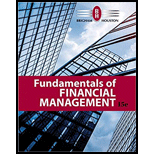
Mindtapv2.0 Finance, 1 Term (6 Months) Printed Access Card For Brigham/houston's Fundamentals Of Financial Management, 15th (mindtap Course List)
15th Edition
ISBN: 9780357114575
Author: Eugene F. Brigham, Joel F. Houston
Publisher: Cengage Learning
expand_more
expand_more
format_list_bulleted
Concept explainers
Textbook Question
Chapter 13, Problem 5P
OPTIMAL CAPITAL BUDGET Hampton Manufacturing estimates that its VVACC is 125%. The company is considering the following 7 investment projects:
| Project | Size | |
| A | $750,000 | 14.0% |
| B | 1,250,000 | 13.5 |
| C | 1,250,000 | 13.2 |
| D | 1,250,000 | 13.0 |
| E | 750,000 | 12.7 |
| F | 750,000 | 12.3 |
| G | 750,000 | 12.2 |
- a. Assume that each of these projects is independent and that each is just as risky as the firm’s existing assets. Which set of projects should be accepted, and what is the firm’s optimal capital budget?
- b. Now assume that Projects C and D are mutually exclusive. Project D has an
NPV of $400,000, whereas Project C has an NPV of $350,000. Which set of projects should be accepted, and what is the firm’s optimal capital budget? - c. Ignore part b and assume that each of the projects is independent but that management decides to incorporate project risk differentials. Management judges Projects B, C, D, and E to have average risk. Project A to have high risk, and Projects F and G to have low risk. The company adds 2% to the WACC of those projects that are significantly more risky than average, and it subtracts 2% from the WACC of those projects that are substantially less risky than average. Which set of projects should be accepted, and what Is the firm’s optimal capital budget?
Expert Solution & Answer
Want to see the full answer?
Check out a sample textbook solution
Students have asked these similar questions
Please don't use hand rating
"Dividend paying stocks cannot be growth stocks" Do you agree or disagree? Discuss choosing two stocks to help justify your view.
"Dividend paying stocks cannot be growth stocks" Do you agree or disagree? Discuss choosing two stocks to help justify your view.
Chapter 13 Solutions
Mindtapv2.0 Finance, 1 Term (6 Months) Printed Access Card For Brigham/houston's Fundamentals Of Financial Management, 15th (mindtap Course List)
Ch. 13 - Explain in general terms what each of the...Ch. 13 - Would a failure to recognize growth options tend...Ch. 13 - Companies often have to increase their initial...Ch. 13 - How might a firms corporate WACC be affected by...Ch. 13 - Prob. 5QCh. 13 - GROWTH OPTION Singh Development Co. is deciding...Ch. 13 - OPTIMAL CAPITAL BUDGET Marble Construction...Ch. 13 - Prob. 3PCh. 13 - ABANDONMENT OPTION The Scampini Supplies Company...Ch. 13 - OPTIMAL CAPITAL BUDGET Hampton Manufacturing...
Knowledge Booster
Learn more about
Need a deep-dive on the concept behind this application? Look no further. Learn more about this topic, finance and related others by exploring similar questions and additional content below.Similar questions
- A firm needs to raise $950,000 but will incur flotation costs of 5%. How much will it pay in flotation costs? Multiple choice question. $55,500 $50,000 $47,500 $55,000arrow_forwardWhile determining the appropriate discount rate, if a firm uses a weighted average cost of capital that is unique to a particular project, it is using the Blank______. Multiple choice question. pure play approach economic value added method subjective approach security market line approacharrow_forwardWhen a company's interest payment Blank______, the company's tax bill Blank______. Multiple choice question. stays the same; increases decreases; decreases increases; decreases increases; increasesarrow_forward
- For the calculation of equity weights, the Blank______ value is used. Multiple choice question. historical average book marketarrow_forwardA firm needs to raise $950,000 but will incur flotation costs of 5%. How much will it pay in flotation costs? Multiple choice question. $50,000 $55,000 $55,500 $47,500arrow_forwardQuestion Mode Multiple Choice Question The issuance costs of new securities are referred to as Blank______ costs. Multiple choice question. exorbitant flotation sunk reparationarrow_forward
- What will happen to a company's tax bill if interest expense is deducted? Multiple choice question. The company's tax bill will increase. The company's tax bill will decrease. The company's tax bill will not be affected. The company's tax bill for the next year will be affected.arrow_forwardThe total market value of a firm is calculated as Blank______. Multiple choice question. the number of shares times the average price the number of shares times the future price the number of shares times the share price the number of shares times the issue pricearrow_forwardAccording the to the Blank______ approach for project evaluation, all proposed projects are placed into several risk categories. Multiple choice question. pure play divisional WACC subjectivearrow_forward
- To invest in a project, a company needs $50 million. Given its flotation costs of 7%, how much does the company need to raise? Multiple choice question. $53.76 million $46.50 million $50.00 million $53.50 millionarrow_forwardWhile determining the appropriate discount rate, if a firm uses a weighted average cost of capital that is unique to a particular project, it is using the Blank______. Multiple choice question. economic value added method pure play approach subjective approach security market line approacharrow_forwardWhat are flotation costs? Multiple choice question. They are the costs incurred to issue new securities in the market. They are the costs incurred to insure the payment due to bondholders. They are the costs incurred to meet day to day expenses. They are the costs incurred to keep a project in the business.arrow_forward
arrow_back_ios
SEE MORE QUESTIONS
arrow_forward_ios
Recommended textbooks for you

Capital Budgeting Introduction & Calculations Step-by-Step -PV, FV, NPV, IRR, Payback, Simple R of R; Author: Accounting Step by Step;https://www.youtube.com/watch?v=hyBw-NnAkHY;License: Standard Youtube License